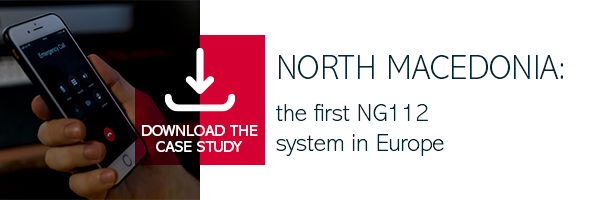Caller location is one of the most crucial pieces of information in emergency response. For this reason, various technologies have been developed to help both citizens and operators automatically identify the location of an emergency. Among these technologies are eCall, designed to notify emergency services directly from the vehicle, and Advanced Mobile Location (AML), for emergency calls from mobile devices. Developed starting in 2014, AML benefited from contributions by organizations such as EENA – the European Emergency Number Association – and is now recognized as an international standard.
What is Advanced Mobile Location?
AML is a technology automatically integrated into all smartphones with iOS or Android operating systems worldwide. When an emergency call is made, the smartphone automatically sends the caller’s location data to the PSAP answering the call. This information allows the operator to accurately pinpoint the location of the person making the call. The location data is sourced from GNSS (Global Navigation Satellite System) technologies, which include the commonly known GPS (Global Positioning System). In urban areas, where a high density of buildings may weaken the signal, GNSS supplements the data with information from Wi-Fi networks to which the smartphone may be connected.
AML, therefore, is not an app that needs to be downloaded from an app store, but a built-in feature of the device itself, requiring no user action for activation. AML transmits location data using SMS transmission protocols, or, less frequently, the HTTPS protocol, sending this information to the Emergency Response Center. The transmission of data incurs no cost for the user and is available in all countries that have implemented AML technology. It’s clear that citizens benefit from AML in several ways:
-
It works automatically;
-
It’s always active;
-
It’s free of charge.
Additionally, AML speeds up emergency response: as soon as the call is received, the caller’s location is immediately available, allowing the nearest emergency services to be dispatched more quickly.
AML: the current status in Europe
With Directive No. 2018/1972, the European Electronic Communications Code (EECC) made it mandatory for EU countries to ensure that emergency calls from smartphones use, where available, location data provided by the devices themselves. As a result, from March 2022, all smartphones sold in Europe must be capable of transmitting caller location data to PSAPs.
Currently, all Android and iOS smartphones are AML-compatible, with the technology already adopted in over 30 countries worldwide. Within the European Union, the technology has been implemented in nearly all countries (including the United Kingdom), with varying levels of functionality depending on the mobile operator. EENA’s 2023 AML Report Card Update offers a detailed breakdown of the services available from each telecom operator in each member state. This is particularly important for verifying key functionalities such as international roaming, Text-to-112, or equivalent services.
AML: integration challenges and the role of CAD
AML location data is provided by smartphones, which send the location based on information from satellites, cell towers, or Wi-Fi, according to algorithms specific to the device’s operating system (Android, iOS, etc.). Additionally, the sensitivity of the device’s antenna affects the accuracy of the transmitted data. As a result, location data is not always consistent and depends on uncontrollable variables. This presents both technological and organizational challenges for PSAPs:
-
CAD – Computer-Aided Dispatch, the software that manages and coordinates the PSAP’s activities, must handle the received information in a way that accurately reflects the caller's location, even when signal quality or accuracy varies between different devices. The CAD system needs to integrate the data so that operators can assess and, if necessary, correct the location.
-
SMS Messaging. Although AML can use either text messaging (SMS) or the internet (HTTPs protocol), SMS is often the preferred method. However, since AML is a standardized system, the content of location messages remains the same regardless of the carrier. The CAD system must be capable of properly processing this standardized location information transmitted via SMS.
-
Operator Training. The CAD system must not only display the caller’s location on the map but also provide guidance on the accuracy of the data, which can arrive from different sources (GPS, cell towers, Wi-Fi) within a very short timeframe, depending on the algorithm used. Although the provided location is highly reliable, absolute certainty cannot be guaranteed, especially in urban areas where information from GNSS, cell towers, or Wi-Fi is combined. The location is typically shown with a circle of varying radius, depending on the confidence in the data. Therefore, appropriate training for PSAP operators is essential: based on the accuracy displayed on the map, the call-taker will decide whether and how to ask the caller for confirmation of their location. Since the transmission of SMS depends on network coverage, alternative procedures must also be in place, such as requesting verbal information or triangulating cell towers.

AML technology is of supranational interest and requires the commitment of telecom operators in the involved countries to facilitate roaming. For AML to function outside one’s home country, agreements between institutions and telecom companies are necessary to ensure the uniform routing of SMS messages. Organizations such as EENA monitor the progress made by various countries toward standardization, to guarantee increasingly reliable and precise services for citizens in Europe and around the world.


